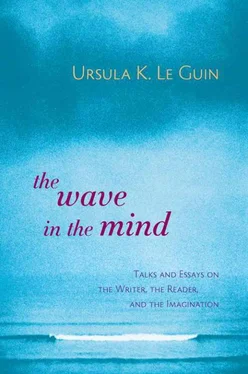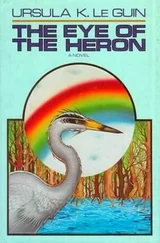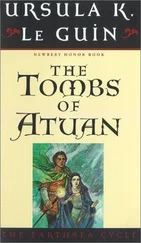The imagination can transfigure the dark matter of life. And in many personal essays and autobiographies, that’s what I begin to miss, to crave: transfiguration. To recognise our shared, familiar misery is not enough. I want to recognise something I never saw before . I want the vision to leap out at me, terrible and blazing—the fire of the transfiguring imagination. I want the true dragons.
Experience is where the ideas come from. But a story isn’t a mirror of what happened. Fiction is experience translated by, transformed by, transfigured by the imagination. Truth includes but is not coextensive with fact. Truth in art is not imitation, but reincarnation.
In a factual history or memoir, the raw material of experience, to be valuable, has to be selected, arranged, and shaped. In a novel, the process is even more radical: the raw materials are not only selected and shaped but fused, composted, recombined, reworked, reconfigured, reborn, and at the same time allowed to find their own forms and shapes, which may be only indirectly related to rational thinking. The whole thing may end up looking like pure invention. A girl chained to a rock as a sacrifice to a monster. A mad captain and a white whale. A ring that confers absolute power. A dragon.
But there’s no such thing as pure invention. It all starts with experience. Invention is recombination. We can work only with what we have. There are monsters and leviathans and chimeras in the human mind; they are psychic facts. Dragons are one of the truths about us. We have no other way of expressing that particular truth about us. People who deny the existence of dragons are often eaten by dragons. From within.
Another way we have recently taken of showing our deep distrust of the imagination, our puritanical lust to control it and limit it, is in the way we tell stories electronically, on TV and in media such as electronic games and CD-ROMs.
Reading is active. To read a story is to participate actively in the story. To read is to tell the story, tell it to yourself, reliving it, rewriting it with the author, word by word, sentence by sentence, chapter by chapter…. If you want proof, just watch an eight-year-old reading a story she likes. She is concentratedly, tensely, fiercely alive. She is as intense as a hunting cat. She is a tiger eating.
Reading is a most mysterious act. It absolutely has not been replaced and will not be replaced by any kind of viewing. Viewing is an entirely different undertaking, with different rewards.
A reader reading makes the book, brings it into meaning, by translating arbitrary symbols, printed letters, into an inward, private reality. Reading is an act, a creative one. Viewing is relatively passive. A viewer watching a film does not make the film. To watch a film is to be taken into it—to participate in it—be made part of it. Absorbed by it. Readers eat books. Film eats viewers.
This can be wonderful. It’s wonderful to be eaten by a good movie, to let your eyes and ears take your mind into a reality you could never otherwise know. However, passivity means vulnerability; and that’s what a great deal of media storytelling exploits.
Reading is an active transaction between the text and the reader. The text is under the control of the reader—she can skip, linger, interpret, misinterpret, return, ponder, go along with the story or refuse to go along with it, make judgments, revise her judgments; she has time and room to genuinely interact. A novel is an active, ongoing collaboration between the writer and the reader.
Viewing is a different transaction. It isn’t collaborative. The viewer consents to participate and hands over control to the filmmaker or programmer. Psychically there is no time or room outside an audiovisual narrative for anything but the program. For the viewer, the screen or monitor temporarily becomes the universe. There’s very little leeway, and no way to control the constant stream of information and imagery—unless one refuses to accept it, detaches oneself emotionally and intellectually, in which case it appears essentially meaningless. Or one can turn the program off.
Although there’s a lot of talk about transactional viewing and interactive is a favorite word of programmers, the electronic media are a paradise of control for programmers and a paradise of passivity for viewers. There is nothing in so-called interactive programs except what the programmer put in them; the so-called choices lead only to subprograms chosen by the programmer, no more a choice than a footnote is—do you read it or don’t you? The roles in role-playing games are fixed and conventional; there are no characters in games, only personae. (That’s why teenagers love them; teenagers need personae. But they have to shed those personae eventually, if they’re going to become persons.) Hypertext offers the storyteller a wonderful complexity, but so far hypertext fiction seems to be like Borges’s garden of forking paths that lead only to other forking paths, fascinating, like fractals, and ultimately nightmarish. Interactivity in the sense of the viewer controlling the text is also nightmarish, when interpreted to mean that the viewer can rewrite the novel. If you don’t like the end of Moby Dick you can change it. You can make it happy. Ahab kills the whale. Ooowee.
Readers can’t kill the whale. They can only reread until they understand why Ahab collaborated with the whale to kill himself. Readers don’t control the text: they genuinely interact with it. Viewers are either controlled by the program or try to control it. Different ball games. Different universes.
When I was working on this talk, a 3-D animated version of The Little Prince came out on CD-ROM. The blurb said it “offers more than just the story of the Little Prince. You can, for example, catch an orbiting planet in the Little Prince’s universe and learn all about the planet’s secrets and its inhabitants.”
In the book the prince visits several planets, with extremely interesting inhabitants, and his own tiny planet has an immense secret—a rose—the rose he loves. Do these CD guys think Saint-Exupéry was stingy with his planets? Or are they convinced that stuffing irrelevant information into a work of art enriches it?
Ah, but there is more: you can “enter the Fox Training Game and after you’ve ‘tamed’ the fox that the Little Prince meets, he will give you a gift.”
Do you remember the fox, in The Little Prince ? He insists that the little prince tame him. Why? the prince asks, and the fox says that if he is tamed he will always love the wheat fields, because they’re the color of the little prince’s hair. The little prince asks how to tame him, and the fox says he has to do it by being very patient, sitting down “at a little distance from me in the grass. I shall look at you out of the corner of my eye, and you will say nothing. Words are the source of misunderstanding. But you will sit a little closer to me every day….” And it should be at the same time every day, so that the fox will “know at what hour my heart is to be ready to greet you. One must observe the proper rites.”
And so the fox is tamed, and when the little prince is about to leave, “Ah,” said the fox, “I shall cry.” So the little prince laments, “Being tamed didn’t do you any good,” but the fox says, “It has done me good, because of the color of the wheat fields.” And when they part, the fox says, “I will make you a present of a secret…. It is the time you wasted for your rose that makes your rose important…. You become responsible, forever, for what you have tamed.”
Читать дальше




